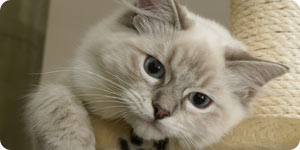
Older cats are more sedentary than younger ones, and usually easier housemates, since they are less ‘crazy,’ but they have unique health issues that you should be aware of.
- If your cat strains without producing anything in the litter box, he may have crystals in his urinary tract. This is common in cats who eat a ‘high-ash’ diet, and there are ‘low-ash’ cat foods specifically designed to prevent this. This condition must be treated by a vet–it will not get better on its own.
- Older cats can easily become dehydrated. Any cat should never be left in a car on a hot day, but older cats need special monitoring. Dehydration can kill a cat inside of a day, so don’t wait if you think your cat is dehydrated. You can check for this by plucking up a fold of skin. The well-hydrated cat’s skin will snap back into place when released. A dehydrated cat–indeed, any animal–will have skin that will only slowly return to its place. Dehydration is easily treated at your vet’s, or if this is a chronic problem, you can be taught to give your cat fluids at home.
- Older cats often lose their sense of smell, which hampers theirappetite and they need to be tempted to eat. Weight loss can be dangerous for cats, particularly rapid weight loss, which can cause very dangerous–often fatal–liver disease. If your cat has eaten dry kibble most of his life and suddenly is uninterested, try canned cat food. This may be just the treat they wanted to get them interested again. You can tempt a canned cat food eater with jars of baby food. Gerber’s baby beef is a big hit with every cat I’ve ever had–try lamb and veal as well. Some cats respond to garlic powder, some to creamed corn. Experiment to see what works for your picky senior.
- Grooming is essential for older cats. They often will forget to groom themselves, so make sure you brush them once a day. Clumps in the fur pulls and is very uncomfortable, and makes the cat even less likely to groom, so keep long-haired cats clump-free.
- Make sure your indoor cat has plenty of exercise toys–a tall scratching post that he can stretch up on, and things to run and jump on. Dashing up and down stairs is great for exercise–try tossing the catnip mouse up the stairs. Some cats can even be taught to fetch and retrieve!
- Your cat may need greens in his diet as he gets older. I had a cat who stole asparagus off the plate. Try growing ‘cat grass’ for your kitties. Or offer them a green bean off your plate; a surprising number of cats enjoy the occasional vegetable. But please don’t give your cat milk. It’s a cliché that cats love it, but all cats are lactose-intolerant, and milk gives them diarrhea, which can lead to dehydration. A little bite of cheese, perhaps, but no milk!
- Older cats often develop kidney disease. In the acute form, it’s pretty serious and possibly fatal. But a cat with chronic kidney disease can live another two or three years with a good quality of life with home care. Treating chronic kidney disease is usually a simple matter of providing subcutaneous fluids for your cat on a regular schedule; this flushes the kidneys and is the kitty equivalent of dialysis. This involves the bags and tubes and needles such as vets use, but is very simple to do yourself. If your vet suggests a regular regime of fluids for your cat, don’t say you can’t do it and let the cat suffer without, or put him to sleep. Let the vet show you how easy it is, and when you see how much the cat comes to appreciate how much better the fluids make him feel, you’ll be glad you did.
Older cats love a lap, so make sure you set aside an hour or two to sit down in your favorite chair and ‘make a lap’ for your oldest friend.
